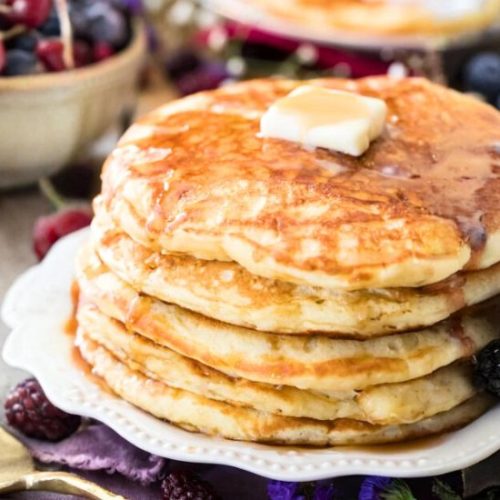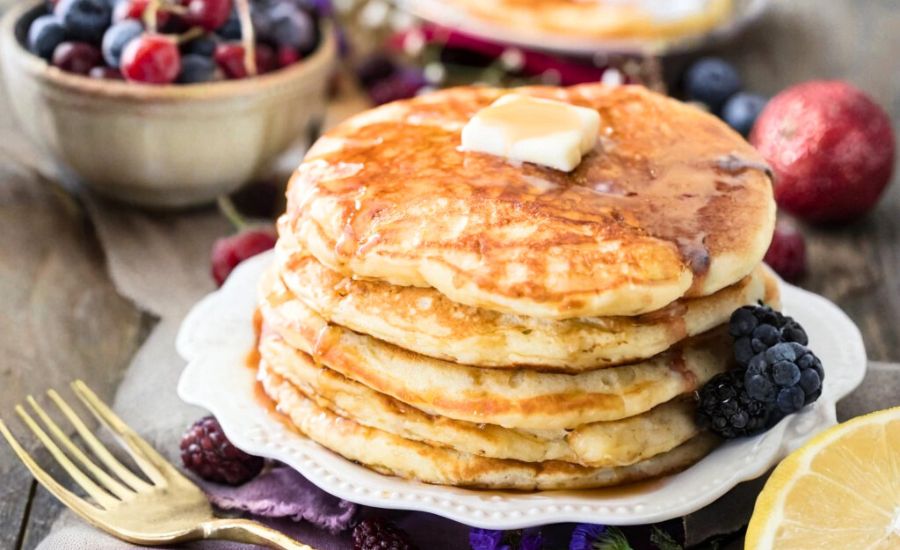All products are selected by our editorial team for quality. If you buy through our links, we may earn a small commission at no extra cost to you.
Buttermilk pancakes are a beloved breakfast staple, and this recipe stands out for delivering irresistibly thick, soft, and fluffy pancakes in under 15 minutes.
What makes this recipe truly special is the perfect balance of ingredients and technique — combining baking powder and baking soda with buttermilk creates an optimal rise and tender crumb.
The use of buttermilk not only enhances flavor but also adds a subtle tang that beautifully complements the sweetness, elevating the taste beyond basic pancakes.
From a nutritional perspective, these pancakes provide a balanced breakfast option.
They offer a moderate protein boost thanks to eggs and buttermilk, supporting muscle repair and energy throughout the morning.
While these pancakes contain carbohydrates to fuel your day, they also include essential fats from melted butter, which contribute to satiety and flavor.
Unlike many overly processed breakfast options, this recipe uses whole ingredients with no artificial additives, making it a cleaner choice.
This recipe’s simplicity and quick preparation make it perfect for everyday cooking.
It doesn’t require fancy equipment or hard-to-find ingredients, and the batter can even rest while you prep your skillet, making the process smooth and efficient.
Plus, the recipe scales well for family breakfasts or weekend brunches, satisfying hungry appetites with minimal fuss.
Whether you’re feeding a crowd or craving a comforting solo breakfast, these pancakes hit the spot every time with fluffy texture and rich flavor.
Must-Have Tools for Perfect Results
Non-Stick Skillet
A high-quality non-stick skillet is essential for evenly cooking pancakes without sticking or burning.
It ensures smooth flipping and easy cleanup. Beyond pancakes, it’s perfect for sautéing vegetables, cooking eggs, and preparing delicate dishes that require gentle heat.
Mixing Bowls Set
Durable mixing bowls make combining dry and wet ingredients effortless. Using separate bowls prevents overmixing and keeps the batter light and airy.
These bowls are versatile for all baking and cooking needs, from marinating to tossing salads.
Whisk
A sturdy whisk is crucial for smoothly blending buttermilk, eggs, and vanilla while evenly incorporating melted butter. It helps avoid lumps and promotes a consistent batter texture.
Whisks are indispensable for emulsifying dressings, whipping cream, or beating eggs.
Measuring Cups & Spoons
Accurate measurements guarantee the perfect pancake texture and rise every time.
Using reliable measuring tools helps maintain recipe consistency and prevents mistakes. They’re vital for baking precision and everyday cooking success.
Pancake Spatula
A thin, flexible pancake spatula allows gentle flipping without tearing or breaking pancakes.
It helps achieve golden-brown perfection on both sides. This spatula is also handy for delicate foods like fish or omelets.

Buttermilk Pancakes
Equipment
- 1 large mixing bowl
- 1 Medium mixing bowl
- 1 Whisk
- 1 Wooden spoon or spatula
- 1 Non-stick skillet or griddle
- Measuring cups and spoons
Ingredients
- 2 cups 250g all-purpose flour
- 3 tablespoons granulated sugar
- 2 teaspoons baking powder
- ½ teaspoon baking soda
- ½ teaspoon salt
- 2¼ cups 530ml buttermilk
- 2 large eggs lightly beaten (preferably at room temperature)
- 1 teaspoon vanilla extract
- 4 tablespoons 57g unsalted butter, melted and cooled
Instructions
- Combine Dry Ingredients: In a large mixing bowl, whisk together the flour, sugar, baking powder, baking soda, and salt until well blended. This ensures even distribution of leavening agents for a consistent rise.
- Mix Wet Ingredients: In a separate medium bowl, whisk together the buttermilk, eggs, and vanilla extract until smooth.
- Incorporate Butter: Slowly drizzle the melted butter into the wet ingredients while whisking continuously. Don’t worry if the mixture looks a bit curdled; this is normal and will come together when mixed with the dry ingredients.
- Make the Batter: Pour the wet ingredients into the dry ingredients. Using a wooden spoon or spatula, gently stir just until combined. It’s important not to overmix; some lumps or streaks of flour are fine and help keep the pancakes tender.
- Prepare the Skillet: Heat a non-stick skillet or griddle over medium-low heat. Lightly grease it with cooking spray or a small amount of oil. Allow it to fully preheat — this usually takes around 5 minutes. A well-heated pan ensures even cooking and prevents sticking.
- Cook Pancakes: Scoop about ½ to ⅔ cup of batter per pancake onto the skillet. Let cook until bubbles form on the surface and edges start to look set, about 2-3 minutes. Carefully flip the pancake with a spatula and cook for another 2 minutes or until golden brown.
- Repeat: Continue cooking remaining batter, greasing the skillet between batches as needed to keep pancakes from sticking.
- Serve: Serve pancakes warm with your favorite toppings such as butter, maple syrup, fresh fruit, or yogurt.
Notes
- Buttermilk Substitute: If you don’t have buttermilk, mix 1 cup of milk with 1 tablespoon of lemon juice or white vinegar and let it sit for 5 minutes before using. Note that this may slightly thin the batter, so add gradually and adjust as needed.
- Resting Batter: Allowing the batter to rest while the skillet heats helps the flour fully hydrate and can result in fluffier pancakes.
- Avoid Overmixing: Stirring too much can develop gluten, causing tough pancakes. Stop mixing once the ingredients are just combined.
- Storage: Leftover pancakes can be stored in an airtight container in the fridge for up to 3 days or frozen for longer storage. Reheat in a toaster or skillet before serving.
Chef’s Secrets for Fluffy Perfection
Achieving perfectly thick and fluffy pancakes comes down to a few key techniques. First, always use fresh baking powder and baking soda to ensure the batter rises properly and stays light.
Mixing the wet and dry ingredients separately before combining helps avoid overmixing, which can develop gluten and lead to dense pancakes.
A slightly lumpy batter is ideal — resist the urge to over-stir. Letting the batter rest while the skillet heats allows the flour to fully hydrate, creating an even softer texture.
Cooking over medium-low heat might take a little longer, but it prevents burning and cooks the pancakes evenly inside and out.
Finally, gently flipping the pancakes only once keeps them tender and prevents deflation.
Serving Suggestions for Delicious Pancakes
These buttermilk pancakes pair wonderfully with classic toppings like melted butter and real maple syrup, enhancing their subtle tang.
For a fresh twist, try adding a dollop of Greek yogurt and a handful of seasonal berries such as blueberries, strawberries, or raspberries for natural sweetness and texture.
You can also drizzle with honey or sprinkle chopped nuts like walnuts or pecans for added crunch.
For a heartier breakfast, serve alongside scrambled eggs, crispy vegetarian sausage, or sautéed mushrooms.
Don’t forget a warm cup of coffee or freshly brewed tea to complete the perfect morning meal.
Storage Tips to Keep Pancakes Fresh
If you have leftover pancakes, store them properly to maintain their flavor and texture.
Allow the pancakes to cool completely before placing them in an airtight container or resealable plastic bag.
In the refrigerator, they will stay fresh for up to three days. For longer storage, freeze the pancakes in a single layer on a baking sheet, then transfer them to a freezer-safe bag or container.
When ready to enjoy, reheat refrigerated pancakes in a toaster or on a skillet over low heat until warmed through.
Frozen pancakes can be reheated in a toaster or microwave, but using a skillet helps restore their original crispness.
Frequently Asked Questions About Pancakes
1. Can I substitute regular milk for buttermilk?
Yes! If you don’t have buttermilk on hand, you can make a quick substitute by adding 1 tablespoon of lemon juice or white vinegar to 1 cup of milk.
Let it sit for 5 minutes until slightly thickened and use as directed. This will give the pancakes their characteristic tang and help activate the baking soda.
2. Why are my pancakes dense instead of fluffy?
Dense pancakes usually result from overmixing the batter, which develops gluten and makes the texture tough.
Be sure to gently stir the batter just until the dry ingredients are moistened, leaving some lumps.
Also, check that your baking powder and baking soda are fresh, as expired leavening agents won’t give proper rise.
3. Can I prepare the batter the night before?
It’s best to make the batter fresh to enjoy the fluffiest pancakes. Buttermilk reacts with baking soda and baking powder, so the batter loses its rising power over time.
If you want to prepare in advance, mix the dry ingredients separately and store them. Then combine with wet ingredients just before cooking.
4. How do I know when to flip the pancakes?
Wait until you see bubbles forming across the surface of the batter and the edges start to look set and slightly dry.
This usually takes about 2-3 minutes. Gently lift one edge with a spatula to check for a golden brown color before flipping.
5. Can I add mix-ins like blueberries or chocolate chips?
Absolutely! Fold in fresh or frozen blueberries, chocolate chips, or even chopped nuts gently into the batter just before cooking.
Avoid stirring too vigorously to keep the batter light and tender.
Adding mix-ins makes the pancakes even more special and flavorful.
This recipe is inspired by Sugarspunrun and has been carefully refined to enhance clarity, streamline preparation steps, and ensure accurate results. We’ve also included health benefits, nutritional highlights, and Must-Have Tools to help you get the best results every time you cook.


